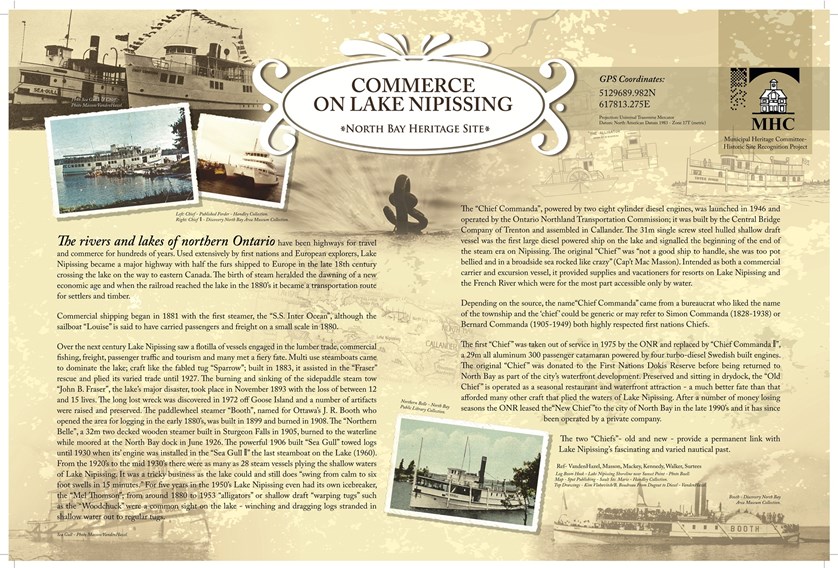Commerce on Lake Nipissing Heritage Site Plaque
- Site P17:
- Commerce on Lake Nipissing Heritage Site Plaque
- Location:
- North Bay Waterfront
- Evaluation Score:
- N/A
The rivers and lakes of northern Ontario have been highways for travel and commerce for hundreds of year. Used extensively by First Nations and European explorers, Lake Nipissing became a major highway with half the furs shipped to Europe in the late 18th century crossing the lake on the way to eastern Canada. The birth of steam heralded the dawning of a new economic age and when the railroad reached the lake in the 1880s it became a transportation route for settlers and timber.
Commercial shipping began in 1881 with the first steamer, the “S.S. Inter Ocean”, although the sailboat “Louise” is said to have carried passengers and freight on a small scale in 1880.
Over the next century Lake Nipissing saw a flotilla of vessels engaged in the lumber trade, commercial fishing, freight, passenger traffic and tourism and many met a fiery fate. The burning and sinking of the side paddle steam tow “John B. Fraser”, the lake’s major disaster, took place in November 1893 with the loss of between 12 and 15 lives. The long lost wreck was discovered in 1972 off Goose Island and a number of artifacts were raised and preserved. From the 1920s to the mid-1930s there were as many as 28 steam vessels plying the shallow waters of Lake Nipissing. It was a tricky business as the lake could and still does “swing from calm to six foot swells in 15 minutes.” For five years in the 1950s Lake Nipissing even had its own icebreaker, the “Mel Thomson”; from around 1880 to 1953 “alligators” or shallow draft “warping tugs” such as the “Woodchuck” were a common sight on the lake – winching and dragging logs stranded in shallow water out to regular tugs.
The “Chief Commanda”, powered by two eight cylinder diesel engines, was launched in 1946 and operated by the Ontario Northland Transportation Commission; it was built by the Central Bridge Company of Trenton and assembled in Callander. The 31m single screw hulled shallow draft vessel was the first large diesel powered ship on the lake and signalled the beginning of the end of the steam era on Nipissing. Intended as both a commercial carrier and excursion vessel, it provided supplies and vacationers for resorts on Lake Nipissing and the French River which were for the most part accessible only by water.
Depending on the source, the name “Chief Commanda” came from a bureaucrat who liked the name of the township and the ‘chief’ could be generic or may refer to Simon Commanda (1828-1938) or Bernard Commanda (1905-1949) both highly respected first nations Chiefs.
The first “Chief” was taken out of service in 1975 by the ONR and replaced by “Chief Commanda II”, a 29m aluminum 300 passenger catamaran powered by four turbo-diesel Swedish built engines. Preserved and sitting in dry-dock, the “Old Chief” is operated as a seasonal restaurant and waterfront attraction – a much better fate than that afforded many other craft that plied the waters of Lake Nipissing. After a number of money losing seasons the ONR leased the “New Chief” to the city of North Bay in the late 1990s and it has since been operated by a private company.
The two “Chiefs” – old and new – provide a permanent link with Lake Nipissing’s fascinating and varied nautical past.

